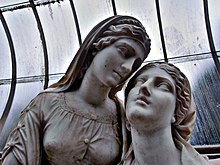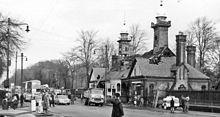Glasgow Botanic Gardens
 | |
| Location | |
|---|---|
Key people |
|
| Website | The Friends of Glasgow Botanic Gardens |
Glasgow Botanic Gardens is a botanical garden located in the West End of Glasgow, Scotland. It features several glasshouses, the most notable of which is the Kibble Palace.
The Gardens has a wide variety of temperate and tropical flora,
The
The Botanic Gardens was awarded a Green Flag Award in 2011.[1]
History
In 1817 about 8 acres (32,000 m2) of land were laid out at Sandyford, near Sauchiehall Street, Glasgow, and run by the Royal Botanic Institution of Glasgow (founded by
The site was once served by a railway line, and Botanic Gardens Railway Station remains today in a derelict state as a remarkable example of a disused station. It is hidden behind some trees and a metal fence blocks access to the platforms. Kirklee railway station also lies just inside the gardens.
Kibble Palace

The Kibble Palace is a 19th-century
The building structure is of curved
In the 1920s a statue was added in the palace to "King Robert of Sicily", a figure from the works of the American poet Henry Wadsworth Longfellow. This is by the Scottish sculptor George Henry Paulin.
In 2004 a £7 million restoration programme was initiated to repair corrosion of the ironwork. The restoration involved the complete dismantling of the palace, and the removal of the parts to Shepley Engineers in Shafton, South Yorkshire for specialised repair and conservation. The plant collection was removed completely for the first time ever, and the ironwork was rebuilt over a rearranged floorplan, giving the palace a prolonged life. It re-opened to the public in November 2006.
The building contains a large collection of orchids, carnivorous plants and tree ferns.
Sculptures in Kibble Palace
- King Robert of Sicily (a hero created by Longfellow) by George Henry Paulin (1927)
- Cain by Edwin Roscoe Mellins (1899)
- Eve by Scipione Tadolini (c. 1870)
- Ruth by Giovanni Ciniselli (1880)
- The Sisters of Bethany by John Warrington Wood (about 1871)
- The Elf by William Goscombe John(1899)
- Stepping Stones by William Hamo Thornycroft(1878)
- The Nubian Slave by Antonio Rossetti (c. 1880)
- sculptures in the Glasgow Botanic Gardens
-
The Sisters of Bethany
-
The Elf
-
Cain
Library
The Gardens has a small but long-established research library. It contains over 2,300 items in its main books collection, a hundred items in special collections, a range of botanical periodicals, and a run of Curtis's Botanical Magazine (1787-present).[8]
The library is not a public library but a reference collection for those working directly with the Gardens, and for botanical or horticultural students and researchers.[9]
Gallery
- Glasgow Botanic Gardens
-
The main hothouses in 2005
-
carnivorous plantsgallery
-
A reflective multi-facet mirror in the restored Kibble Palace
-
The Gardens in August 1966
-
Entrance to the gardens, 1966
-
Botanic Gardens railway station, 1970
-
The disused railway station tunnel
-
Steps running down to the River Kelvin
-
The Gardens (c. 1975).
-
Ceiling of the Kibble Palace
References
- ^ a b "Glasgow Botanic Gardens". Glasgow.co.uk. 15 September 2015.
- ^ "Ferns (Arborescent)". Plant Heritage. Retrieved 13 May 2018.
- ^ "Their Imperial Highnesses Prince and Princess Tomohito of Mikasa - the Imperial Household Agency". Kunaicho.go.jp.
- ^ "Biography of James Jeffray". www.universitystory.gla.ac.uk. Retrieved 18 September 2021.
- ^ Encyclopædia Britannica, 1911
- ^ "John Kibble". The Glasgow Story. Retrieved 4 November 2008.
- ^ "Scottish Ironworks - News". Scottish Ironworks. Summer 2005. Archived from the original on 10 June 2008. Retrieved 26 August 2008.
- ^ "Library | TinyCat".
- ^ "TinyCat's January Library of the Month: Glasgow Botanics Library « the LibraryThing Blog".
External links
 Media related to Glasgow Botanic Gardens at Wikimedia Commons
Media related to Glasgow Botanic Gardens at Wikimedia Commons- Glasgow Botanic Gardens – Glasgow City Council
- Friends of the Glasgow Botanic Gardens
- Archive photographs of the Kibble's Restoration
- Photographs on Flickr
- Library catalogue













